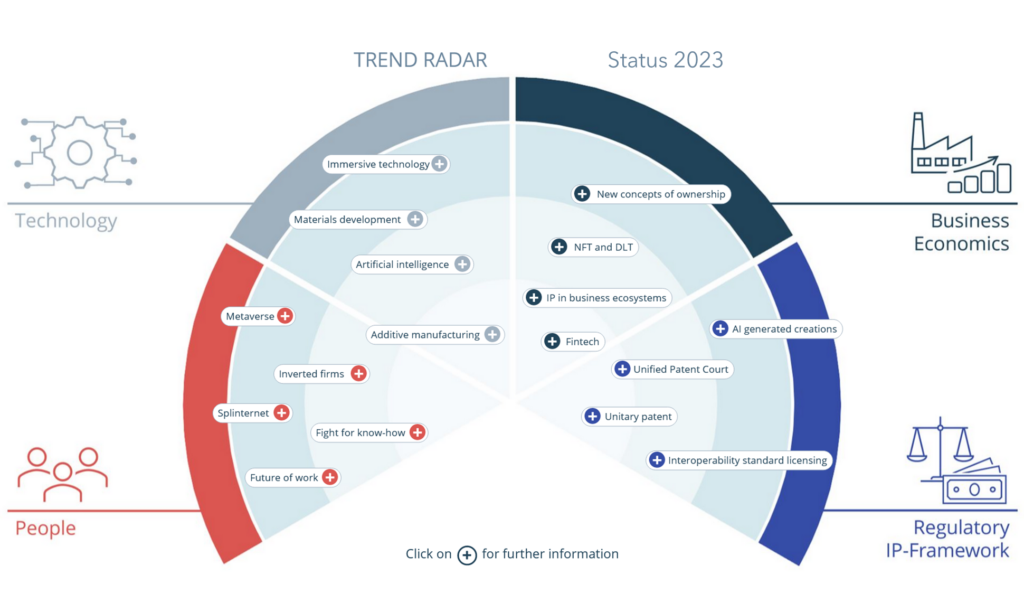Awareness Building for IP under New Work Conditions
We are currently seeing a continuously accelerating digital transformation in the IP system. Especially, in dealing with the stakeholders of the IP system as well as in the relationship and communication between attorneys and clients, networking and professional exchange between IP experts, for example via social networks such as LinkedIn. The search behaviour for experts and the initiation of personal contacts has also changed due to social distancing during the Corona pandemic and the current “new normal work“.
Awareness Building for IP is important
In the context of intellectual property, awareness building refers to the process of educating and informing the public about the importance and value of IP, as well as the rights and protections it provides and what the role of IP experts especially IP attorneys is.
Awareness building activities include:
- Educational campaigns aimed at informing the industry and the public about the different types of IP and how they can be used to protect creative and innovative works
- Informing people about the legal and economic benefits of protecting IP
- Educating people about the importance of respecting IP rights and how to avoid infringing on them
- Raising awareness about the negative consequences of IP infringement, such as lost income for creators and businesses, and economic harm
- Increasing awareness about the resources and tools available for protecting and enforcing IP rights
Overall, IP awareness building helps to create a culture that values and respects creativity, innovation and encourages fair trade.
The changing framework in the “new work” situation
“New work” refers to the adoption of digital technologies and methods that are transforming how awareness building, business development and communication with (new) clients happens for IP experts.
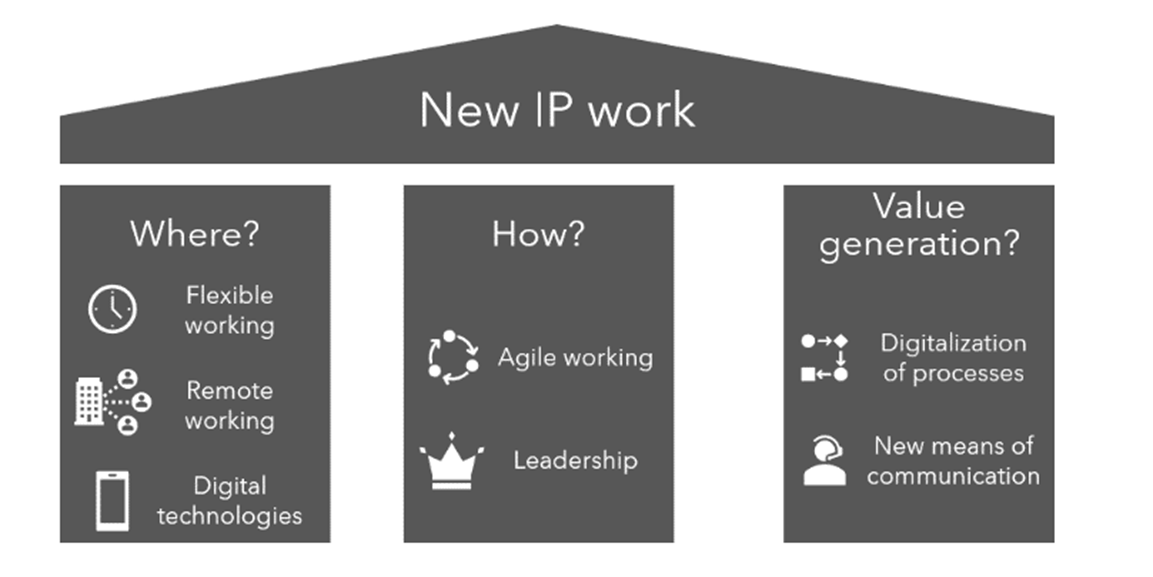 The pandemic has greatly changed the way people work virtually overnight. People are now returning to their offices (at least in part), and the way we work has changed significantly. How can IP experts and innovation teams offer more flexibility, while ensuring that engagement and productivity remain the same or even increase?
The pandemic has greatly changed the way people work virtually overnight. People are now returning to their offices (at least in part), and the way we work has changed significantly. How can IP experts and innovation teams offer more flexibility, while ensuring that engagement and productivity remain the same or even increase?
The new flexibility of work, including the ability to work remotely, means that people are less and less physically available, which results in more digital communication such as email, video conferencing and social networking. Agile working means more integration of IP into innovation processes and continuous information about the work of innovation teams and clients. It also means letting clients know what expertise you have as an IP expert and creating visibility for your expertise.
In particular LinkedIn, by far the world’s largest social network for professional exchange, plays a special role in the digitalization of IP awareness and especially in business development for IP experts. It transforms the way contacts are initiated, how existing and potential clients find out about experts and attorneys. Visibility as an expert in the field is thus also established via Google searches, since a person search there immediately links to LinkedIn profiles, even if the searcher is not a LinkedIn member.
Empirical Facts on the Digitalization of the Relationship between IP Experts and Clients
In a recent study by the CEIPI IP Business Academy:
https://ipbusinessacademy.org/survey-digitalization-of-the-client-relationship
among European patent and trademark attorneys, the following theses are predominantly agreed on:
- The digital record is part of the “New Work”
- Digital, tool-supported collaboration with clients is a reality
- Digital collaboration is done as directly as possible with clients’ systems
- Digital collaboration is valued by clients
- Digital collaboration is increasing efficiency
- The work in law firms and IP departments becomes virtually completely paperless
- Collaboration within the firm is largely digital
Furthermore, the vast majority of respondents believe that the “new work” conditions will not change back to the pre-pandemic situation, regarding the law firm itself, the client interaction or the question of how to attract new clients.
The Importance of LinkedIn for IP Awareness and Business Development
 The survey also asks about the importance of the social network LinkedIn for IP awareness creation and business development of IP professionals. LinkedIn is a social media platform that is focused on professional networking. It is a platform where users can create a profile highlighting their education, work experience, skills, and accomplishments, and connect with other professionals in their industry or field. Users can use LinkedIn to build a professional network, search for potential business partners or clients, stay up-to-date on industry news, and share their own professional insights and updates. LinkedIn also offers a number of features to help professionals to build their brand. LinkedIn is growing by 15% annually with over 830 million members and is by far the most important network for legal advisors and IP experts.
The survey also asks about the importance of the social network LinkedIn for IP awareness creation and business development of IP professionals. LinkedIn is a social media platform that is focused on professional networking. It is a platform where users can create a profile highlighting their education, work experience, skills, and accomplishments, and connect with other professionals in their industry or field. Users can use LinkedIn to build a professional network, search for potential business partners or clients, stay up-to-date on industry news, and share their own professional insights and updates. LinkedIn also offers a number of features to help professionals to build their brand. LinkedIn is growing by 15% annually with over 830 million members and is by far the most important network for legal advisors and IP experts.
The following theses are predominantly agreed on about the importance of LinkedIn for IP experts:
- To gain visibility with existing and new clients
- To show one’s expertise
- To be informed about clients
- To show clients that you are following them
- To be informed about further developments in the IP community
Additionally, slightly half of respondents (48%) felt that self-promotion and self-congratulation from other LinkedIn users was happening in their respective personal feeds.
The use of resources by IP experts on LinkedIn
The membership fees on LinkedIn are slightly between 100 € and 1.000€ per year. However, personal time must also be invested in order to have an attractive profile and to communicate, achieve visibility, be found, etc. As a rule of thumb, it is assumed that
- Pure observation takes about 15-20 min. per day
- Participating in dialogues takes at least 30 min. per day -> 2,5h per week
- Publishing content and building expert status takes approx. 5-10h per week
Most respondents (72%) agree with this assessment. In addition, few respondents use external resources for LinkedIn work (24%) and most (68%) say that day work limits engagement on LinkedIn.
The degree of satisfaction with previous LinkedIn activities varies greatly:
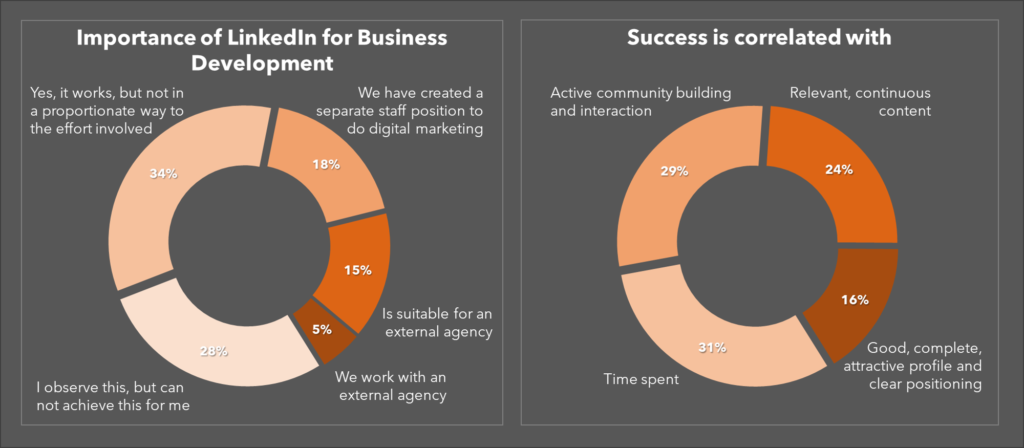
Success factors for IP awareness and business development on LinkedIn
Attorneys often rely on referrals from other lawyers or satisfied clients as a source of new business. Referrals can be particularly valuable because they come with a certain level of trust and credibility, as the person making the referral has had a positive experience with the attorney and is vouching for their abilities. Respondents to the study report that even with a personal referral, the advice seeker checks out the attorney’s profile, field expertise, posts, and comments on LinkedIn before making initial contact.
In addition, the platform is used by IP experts to build and maintain a professional online presence, in order to expand one’s network of contacts and industry connections, gain access to job opportunities and professional development resources. LinkedIn allows experts to share their knowledge and expertise with a wider audience by publishing posts and participating in industry-related discussions.
There are four key success factors for creating awareness for IP and business development for IP experts:
- Building a community
Being part of an appropriate and active community, for example on LinkedIn, blogs and websites, increases the reach, visibility and relevance of your messages.
In business related discussions with others, you can show your expertise and the relevance of the topic for your target group. You can participate in targeted discussions at any time without spatial restrictions and show your expertise visible to everyone. - Profiling target groups
IP can pose a variety of risks and opportunities for a wide range of activities. A lack of understanding can have significant consequences for companies.
Client Centricity means: The better one understands what goals and tasks the target group must accomplish, the more precisely the curation process and framing can work. Therefore, the less disturbing the message is perceived the better it is taken note of. -
Using the right channels
To make yourself heard by the target group, it is essential to address the communication channels that are used and perceived to be credible by the respective target group. Whether on LinkedIn, in newsletters, mailings or at online conferences: Focus your communication where you are perceived by your audience.
We manage access to unique channels in the IP community – influencer, organisations and institutions of national innovation systems. - Framing via content portal
The core of awareness generation is the timely communication of relevant, practice-related content.
Framing is the embedding of important content in a relevant context for the target group. This requires an overview of industries, technologies and developments in the IP community.
To be sustainably relevant, content is required in different levels of detail.
Successful IP awareness building and business development as a data-driven process
The starting point for data-driven IP awareness building and business development is the basic logic of client centricity. Client centricity refers to a business philosophy and strategy that prioritizes the needs and wants of customers in all aspects of the experts’ operations. A client-centric expert is focused on creating positive experiences for its clients and building long-term relationships with them. The goal of client centricity is to understand and meet the needs of individual clients in order to increase customer satisfaction, loyalty, and ultimately, business success.
The data-driven IP awareness building and business development process starts with a persona profile of the target. A client persona is a fictional representation of an IP expert’s ideal client, based on an understanding of the market situation and existing clients. It is used to understand and effectively communicate with the specific target group. A client persona typically includes information about the client’s business situation, goals, values, and pain points. It also can include information about their behaviour patterns, such as where they look for information, with whom they are already connected, who they follow on LinkedIn etc.
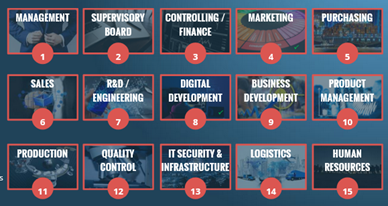 The above-mentioned content portal has already predefined profiles and respective IP needs and issues for nearly every position in the industry. In the figure is an overview of the predefined roles given.
The above-mentioned content portal has already predefined profiles and respective IP needs and issues for nearly every position in the industry. In the figure is an overview of the predefined roles given.
The respective role-specific IP requirements are also stored in these different profiles. These IP needs then serve as a filter in data-driven IP awareness building and business development to ensure that the respective target group only receives IP information that also factually fits the task of the person addressed and represents meaningful, practice-relevant information. The structure of the predefined profiles is structured according to activities in the company. Here is an example of digital  development (in the figure it is #8) and the different main activities and role descriptions that exist in such a field of activity.
development (in the figure it is #8) and the different main activities and role descriptions that exist in such a field of activity.
There are various activities for a specific field of activity such as “Software Development” and these are then assigned to IP-related interests. This means that the respective target group has a specific need for IP-related topics due to their professional activity. These topics in turn represent filters for the data-driven optimization of information relevance for the target group.
This ensures that IP experts can use these predefined target profiles quickly and easily, and these profiles are 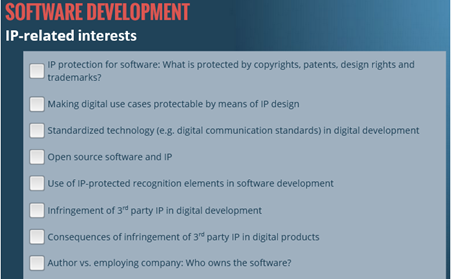 then further refined using the data from the optimization process, thereby ensuring that the practical relevance of the information played out to the target group continues to increase.
then further refined using the data from the optimization process, thereby ensuring that the practical relevance of the information played out to the target group continues to increase.
The next step is the framing process of the individual message for the target group. Information framing refers to the way in which information is presented or framed in order to influence the perception or interpretation of that information by the target group. A frame can be created by using particular words, images, or other elements that evoke a certain emotional response in the target group. Information framing does also refer to the context in which information is presented. Information framing is a powerful technique, to raise the impact and the relevance that the message has on the target group. The necessary framing information, news from sectors, industries, companies, technologies, etc. also come from the content portal and the worldwide sources that cooperate to build awareness for IP.
Due to the 24/7 availability of the digital data and the real-time observability of the reactions in the target groups, the process can be further refined and optimized. This optimization achieves two things: On the one hand, the message played out is relevant for the target group and generates awareness as well as a positive perception of the IP expert as a source of high-quality and practice-relevant information. Secondly, this significantly increases the likelihood that the IP expert will not only be associated with problem-solving skills in the target group, but also that he will be contacted in the event of a relevant topic; one speaks of agenda setting.
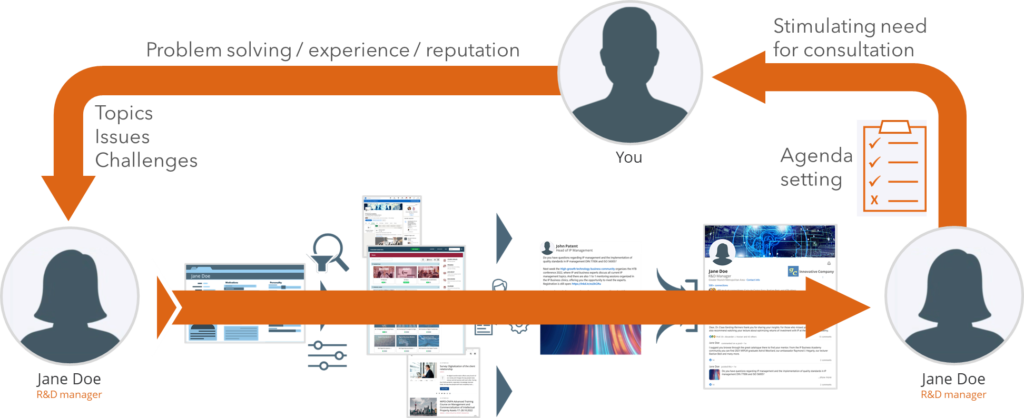
Countless successful examples of this approach can be found on the IP Business Academy blog. We work with IP lawyers, IP departments, service providers and institutions from national and regional innovation systems around the world. We are happy to help.
To ensure that the content portal and the information it contains is always up to date and also covers the latest developments in the field of IP/IP management, the IP Business Academy runs its own Open Foresight Program.
https://ipbusinessacademy.org/open-foresight-program
The resulting radar is publicly available at this link:
https://ipbusinessacademy.org/trend_radar/
